Leeds Castle
 In a rural pocket of Kent, a stone's throw from the M20 motorway, lies one of Britain's most historic sites, brought bang up to date with a calendar of visitor events and an itinerary of feature attractions that make it also one of the most popular.
In a rural pocket of Kent, a stone's throw from the M20 motorway, lies one of Britain's most historic sites, brought bang up to date with a calendar of visitor events and an itinerary of feature attractions that make it also one of the most popular.
Built by a descendant of one of William the Conqueror's barons, fairytale Leeds Castle was first erected in 1119 on foundations that stretch back to Saxon times. Television and film have often captured its beauty, notably in the 1940s Ealing comedy 'Kind Hearts and Coronets' and, latterly, in dramas such as 'The Golden Age'.
Spread over 1200 acres of undulating landscape, the castle's green spaces offer visitors as rich and varied a leisure experience as its heritage - one reason why this spectacular and stimulating independently-managed destination expects 600,000 people through its Norman gatehouse entrance this year - up no less than 20% on 2008.
Leeds is a right royal residence indeed and is open daily round the year. Set majestically on its 'island' site, surrounded by its idyllic moat, the castle boasts royal connections dating from 1278 when it first became part of the Queen of England's dower. During the next 150 years, it was owned by six medieval queens: Eleanor of Castile, Margaret of France, Isabella of France, Joan of Navarre, Anne of Bohemia and Catherine de Valois.
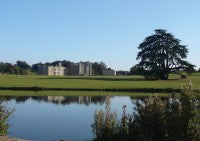 Most famous among its royal heritage though is Henry VIII, who visited frequently with Queen Catherine of Aragon.
Most famous among its royal heritage though is Henry VIII, who visited frequently with Queen Catherine of Aragon.
In 1926, the castle ownership passed into the hands of Olive Wilson Filmer, later Lady Baillie, on marriage to Sir Adrian Baillie ten years later. The daughter of a wealthy American socialite and British aristocrat, Almeric Paget, later Lord Queenborough, she inherited her mother's' fortune aged just seventeen and bought the castle nine years later.
The castle was her lifelong love, and she was committed to returning the by-then crumbling ruin to its former glory by restoring the moated castle and grounds and recreating its Gloriette into a French Gothic fantasy, designed by Armand Albert Rateau.
On her death in 1974, the castle was bequeathed to the Leeds Castle Foundation charitable trust, which set out strict criteria for the maintenance and upkeep of the various aspects of the site - including the castle's pristine grounds, its 9-hole golf course, the many ornamental gardens and its rich diversity of flora and fauna.
Tasked with looking after the grounds is a sixteen-strong groundscare team, led passionately by Estates Grounds Manager, James McConkie, now in his fourth year in the post. Before coming here, James ran his own tree and estate management business after studying forestry and woodland management at Sparsholt College of Agriculture, Winchester.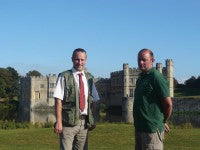
He has amassed a wealth of industry experience in placements that includes a private estate in Berkshire, Defence Estate Organisation in Aldershot and Sandhurst military academy, where he oversaw the management of military training areas.
The team's primary role is to maintain the upkeep of the castle grounds, with the golf course "largely a secondary feature", James acknowledges. "The outlay always needs to be weighed against other areas of the site," he says, "keeping a balance between maintaining the castle grounds, its image and the reasonable maintenance of the golf course."
Set amid heath and parkland, the golf course nevertheless remains an alluring element of the Leeds Castle experience, remaining true to Lady Baillie's philosophy, established when the course was opened in 1936.
"When Lady Baillie bought the castle," recounts James, "she poured a significant amount of money into bringing the castle back to its former glory as a place of residence where guests could come and enjoy a range of sport and leisure pursuits including shooting, croquet, fishing and golf."
Guy Campbell designed the original, private course, provided purely for the enjoyment of her guests. Over the years, however, it opened up to the public, becoming today's pay and play facility. "The course had its heyday in the 1980s," recalls James, "when we were attracting some 36,000 rounds annually on average. That dropped to around 15,000 as local courses proliferated." However, the trend is upwards once more, he adds, "although I don't see us returning to those heady days".
 Head Groundsman, James Smith, nods. He took over the position three years ago after a fifteen year stint as assistant at the site before he moved away to greenkeeping posts in and around London.
Head Groundsman, James Smith, nods. He took over the position three years ago after a fifteen year stint as assistant at the site before he moved away to greenkeeping posts in and around London.
James Smith, meanwhile, had developed his knowledge of irrigation and course reconstruction, amply equipping him to don Leeds' head greenkeeper's hat. "He turned up for the interview armed with a book of portfolio pictures that showed him building and redeveloping our own course," explains James, "so, the decision of whether to offer him the job or not was a no-brainer."
Gazing on a course that had clearly fallen away since the 1980s, both men knew the nine holes needed revitalising.
"I arrived to a depleted machinery stock and with little budget to replace it," explains James. "A Ransomes Mark 10 gang mower was the extent of our machine capability, so some sort of investment was necessary. The grass was cut to a uniform height of 15mm, with no course definition whatsoever."
He twisted a few arms and got the nod to invest in a new Toro fleet to handle the golf course, as well as the castle grounds and estate. "Rough now looks like rough and the greens like greens," declares James Smith proudly, while looking across at the practice green that he had recently sand slitted with a Graden machine.
The emphasis at Leeds has always been on keeping the original features and the golf is no exception, with much of the original 1930s designs remaining, including a 'Mackenzie' hole, with its characteristic contours. 
Some holes have been either reshaped or repositioned - including the one that had skirted the moat - to ensure golf does not hinder the progress of day visitors or interfere with the overall theme of the site, but as James explains: "There is no real scope for development, as golf here is secondary to the rest of our offering, so there's a limit to how far we can improve the course."
The quantity of golf being played under McConkie and Smith's watch is rising, albeit steadily, in recent times. "The demographic is definitely changing," McConkie confirms. "We're aiming much more at the 'BMW' demographic, as players increasingly see this as a prestigious course, with the castle being a feature not found elsewhere in the region."
He describes the course as one of "very high value", with people choosing to play here mainly to enjoy the whole castle experience. "The sporting and leisure tradition here is centuries old and visitors come here for that reason. We can offer the full service, from jousting sessions to classical concerts and we were one of Pavarotti's favourite UK venues for performing."
The castle still has the power to attract a host of regal and celebrity guests, from the royal family itself and top world pop and classical acts to the broadcasting of leading cookery programmes such as Masterchef, whose grand final was held in the castle last year.
 TV chefs The Hairy Bikers also visited this year to film as a part of their tour of the counties, cooking up a storm with local produce including Kentish cob nuts.
TV chefs The Hairy Bikers also visited this year to film as a part of their tour of the counties, cooking up a storm with local produce including Kentish cob nuts.
Despite its huge scope for producing food, the site restricts itself to a small amount of low intensity root vegetables, James says. "The time and manpower would be too great and distract from the true focus of the castle," he explains.
Award-winning wine from the estate's vineyards is also a feature of the Leeds Castle phenomenon and it produces 7,000 to 8,000 bottles of sparkling wine a year. "The ancient vineyard is one of the oldest recorded sites we have here," he adds. "The original has roots that can be traced back to a citation in the Domesday Book."
With such a wealth of natural resources, self-sufficiency makes both cost and practical sense. "We produce as much to put back into the castle as we possibly can, and utilise wood from our own trees in our chainsaw mill for everything from kindling and firewood to brass rubbing plates," he says.
Managing the golf course particularly is "all about working with what we have", insists James Smith, "instead of what we could have" - a philosophy close to his heart, as he is a strong advocate of traditional greenkeeping methods.
"I believe firmly in 'old school' ways - using experience and knowledge rather than too much emphasis on science and a reliance on pesticides," he explains. "I vertidrain, scarify and topdress regularly and stick to the principles of good husbandry."
Keeping costs down is also a crucial factor as greenkeeping budgets have to be spread across the whole golf acreage. "We spend very little compared to most golf courses," says James. "The average is around £19,000 a hole - a sum that could easily be spent on sand alone. Price is always the deciding factor. We use the best seed for the cheapest price possible, finding out what works and pushing for the best deal we can."
The team's sturdy environmental ethic prevents them from placing spraying high on the agenda and pesticides use is "kept to a minimum", he states.
"Preventative measures such as regular aeration and scarification is a better method of weed control for us. We manage the ground and try to work with it to prevent invasive weeds taking hold." Some weeds prove too tough for traditional methods though, he concedes, and fusarium is one of the most persistent problems. "When it takes hold, there's little you can do, no matter how big the budget," he says resignedly.
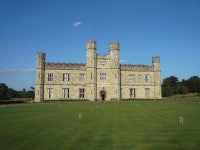 Thatch continues to be his biggest headache, however. "Most golf courses would give up and go home with the amount that we have here," he laughs.
Thatch continues to be his biggest headache, however. "Most golf courses would give up and go home with the amount that we have here," he laughs.
The same might be said of the impressive croquet lawn laid out in front of the castle's main frontage and the location for an outing of the BBC's Antiques Roadshow, Newly mown the morning of my visit, the deep green turf looks immaculate but James says modestly." I do very little to it. The important thing is to maintain a manicured appearance for the visitors."
James McConkie strides off through the castle doorway to reappear moments later with a set of mallets, ready for play. His enthusiasm is infectious.
The golf course and other leisure attractions remain true to their roots, as a compliment to the standing of the Grade 1 listed castle, but are not to the detriment of the Grade 2 listed English Heritage registered grounds.
 Befitting her high society status, Lady Baillie laid out Trust obligations that stretched beyond grounds upkeep - patronising the arts and maintaining the sporting heritage of Leeds Castle among them.
Befitting her high society status, Lady Baillie laid out Trust obligations that stretched beyond grounds upkeep - patronising the arts and maintaining the sporting heritage of Leeds Castle among them.
The late 1980s and early 1990s proved a particularly fruitful period, when the castle hosted international music competitions, such as the one for classical guitar adjudicated by the instrument's leading protagonist, Andres Segovia.
The intervening years have seen the pace of 20th and 21st century technology quicken around the tranquillity of Leeds Castle estate. The team remain ever committed to honouring and delivering the wishes of the heiress, whose legacy shines so brightly. "Many pressures bear down on the estate now," James McConkie admits. "The Kent International Gateway, Eurostar and the M20 being just three of them but the fact that the castle is built in a natural 'bowl' means that, no matter how much development occurs on our doorstep, we will continue to be a corner of old England, and will remain that way for as long as we stay open to the public."
Such stoicism and self-belief can bring a lump to the throat. Hearing him talk so fluently and expansively about this English gem offers hope for the future of Britain's heritage.
Landscaping at Leeds Castle presents one of the estate's most eyecatching and popular attributes and 30,000 to 40,000 local day visitors a year throng here just for its green spaces. Henry VIII, the most famous royal to reside here, is the man largely responsible for making the site as imposing as is witnessed today.
The medieval landscape would probably have been largely treeless, James explains, although there is evidence of pollarding from this period as well as tree specimens dating back to the period.

"The majority of our larger trees have been registered," he states, "and we speculate that some of our chestnuts date back to the commemoration of victory over the Spanish Armada." A particularly gnarled example near the entrance lodge would seem to bear him out on that point.
With over 3,000 notable trees across 120 acres of mixed woodland, maintenance is a crucial aspect to preserving the arboricultural ancestry. James, drawing on his forestry management experience, has recently completed a successful programme to combat ground compaction around two of the largest cedars, which date from the 1820s. The constant tramping of feet across their bases had taken its toll over the years, and remedial action was vital to preserve their structural integrity, he says.
"It was important for us to keep these magnificent trees going, to help stop the erosion and bring them back to their former glory. We're seeing great results and the roots are no longer protruding like they used to."
Much of the later castle landscaping was completed in 1833, in the style of Capability Brown, but the original designs predate this time. Plans available to view span 1749 to 1769 and show widescale work on Leeds' formal areas.
"The Culpeper gardens, which are commonly thought to be a recent addition, actually date back to 1769 as mappings which have recently been discovered reveal," says James.
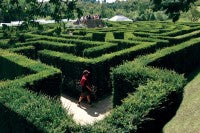 Leeds Castle is thought to have held a strategic position in former times and is located at a key intersection of medieval roads, with the river Len flowing through the estate into the Medway, contributing to its seven kilometres of watercourses.
Leeds Castle is thought to have held a strategic position in former times and is located at a key intersection of medieval roads, with the river Len flowing through the estate into the Medway, contributing to its seven kilometres of watercourses.
"Water has never been a problem for us," says James. "The castle was well designed to ensure there was a ready supply. We hold an abstraction licence and several natural springs also well up. At the time the castle was built, having clean water would make you very wealthy."
However, an abundance of natural spring water does not necessarily mean that irrigation is sorted, as James Smith discovered when he applied quantities to the golf course and couldn't understand why he failed to achieve the desired results. "We found that the natural spring we were sourcing had a pH balance of 7.7, which made it unsuitable for some of our grass species," he reveals.
The estate soil presents "a tale of two halves", adds James McConkie. "On the one side, we have a green sand belt with sandy, slightly acidic, soil. On the other, the soil is reddish brown and we use 350 acres for grazing. Marshy areas predominate where the Len flows through and they are home to an array of flora and fauna, including rare species of orchids and wild grasses."
Few estate managers are blessed with as diverse a range of responsibilities as James and he clearly relishes every day in his post, even the challenges of delivering the high standards that the Leeds bequest requires.
A persistent problem is blue green algae. An unsightly coating of it recently spread across the surface of 'Great Water', the lake created by damming the Len, and triggered by a combination of the rapid warming of its shallow water and the nutrient value of geese droppings.
"We conducted experiments in the water and found that the algae formed on every fourth, fifth and sixth days," he relates, "so we now ensure we rotate the water every third day." An elegant solution.
At one stage, nearly 30% of the water in the moat was infested with the potentially poisonous growth, he adds. Given that the waters are home to carp, bream and wild brown trout, coupled with leisure activities such as raft racing, clean, safe, clear waterways are crucial - which is why he is pondering the prospect of introducing a "microcosmos" to help the water stay naturally clean.
The castle's waterways are merely one habitat supporting a wide biodiversity that are part and parcel of Leeds' stance of environmental protection and support for rare species. "We're a haven for wildlife," he declares, "with some of the world's rarest birds here in our aviary and, in the wild, particularly wetland species."
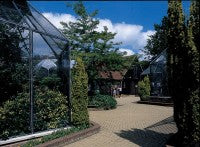 The aviary, run by Laura Gardner, has its focus on conservation, with a range of breeding work undertaken for birds that are either endangered or extinct in the wild. Next year, daily falconry displays will be replaced by the World of Birds, run by a couple who will join the aviary team.
The aviary, run by Laura Gardner, has its focus on conservation, with a range of breeding work undertaken for birds that are either endangered or extinct in the wild. Next year, daily falconry displays will be replaced by the World of Birds, run by a couple who will join the aviary team.
"We're lucky enough to be a stop-off for rare migratory birds - species you wouldn't usually expect to see in the Kent skies, including the osprey and smaller birds such as marsh and reed warblers. We hope the new attraction will give greater value to what the aviary is already doing, including flying displays of some species such as the American Bald Eagle."
The popularity of Leeds with migratory birds and the successful introduction of non-indigenous and rare species, as well as its sustainable populations of water-dwelling mammals, is proof of a successful programme of grounds management. "We know if we're doing a good job or not because the success of wildlife will tell us," says James. "The thriving water vole population is a guide to how well maintained and pure the water is here."
But the strong focus on wildlife conservation and environment in turn presents challenges for James Smith, who, on a tight budget and in the knowledge that pesticides should be shunned if at all possible, has discovered some novel, and highly successful methods of controlling pests without aggressive means on grass repairs.
"I found that applying chilli powder or black pepper where there was evidence of rabbit activity serves as an effective deterrent. They don't like new foods, so if they taste something they either don't like or that isn't familiar to them, they will not return. But the key is to rotate the foods you put down."
The spice wars have also spread to that other perennial pariah - grey squirrels, which persist in devouring the bird food laid down. "They do not like the taste but the birds are unaffected."
Foxes are often a problem for golf courses and estates but the team relies on their years of knowledge to steer them to a sustainable solution, James McConkie explains.
 "Many big estates have focused programmes to keep numbers down but, for us, we find it better to leave them alone. If you kill the master fox, this will cause numbers to rise dramatically as rival males try to take its place. We know the foxes, they know they have a ready food supply, so we've got the balance just right, we believe."
"Many big estates have focused programmes to keep numbers down but, for us, we find it better to leave them alone. If you kill the master fox, this will cause numbers to rise dramatically as rival males try to take its place. We know the foxes, they know they have a ready food supply, so we've got the balance just right, we believe."
An insight into wildlife and an understanding of their habits can help to solve the problems inflicted on the turf. He believes that having such knowledge can ensure grounds teams are well prepared and save them money to boot.
"Leatherjackets are a major problem for us, as our land seems to be particularly attractive to them. Our policy for dealing with insects and such like is definitely a more traditional, back to basics one, not relying on too many chemicals or pesticides."
Glow worms present at Leeds provide a case in point. "Some larvae live on a three-year cycle so one might be fooled into thinking the problem is solved, only to discover a resurgence after a couple of years. You need to understand the lifecycle if you want to control them."
The team work on gaining greater insight into the ecology of the site by working closely with local and regional environmental groups, who can guide and inform on how best to tend and nurture native and rare species. Most recent is their tie-up with Medway Valley Countryside Partnership and the Environment Agency.
"We're keen to glean the right information about wildlife," says James McConkie. "By arming ourselves with knowledge, we're well positioned to apply successfully for financial help and grants, something we rely on to continue our environmental work."
Applying for funding can often be a fraught process, as the upkeep of such an aged edifice as Leeds Castle can throw up surprises, as well as costly specialist building works. "We generally prefer to go for smaller grants which you can see a quick result from. Rather than go for a large investment, we prefer to secure three smaller projects a year that we know we can turn around quickly," he explains. "You only get one shot at the big money so we want to save it for a time when something really significant needs to be done."
Despite the constant challenges of managing such a large estate, he remains devoutly passionate about his role at Leeds. When asked what he does for leisure, he replies without a moment's pause: "This is my leisure. I get to spend my days in a setting like this. What more could I want - being able to live on site and enjoy the perks that the after-hours bring, makes the hard work pale into insignificance.
"I have a two-year-old son, so a castle is a lovely place to raise him - and I have the privilege of literally having the keys to the castle when everyone goes home. I'm also fortunate enough to witness things most people never get the chance to. Watching and recording a rare species of bat roost was special for me. Moments like this you rarely capture in other jobs."
Images © Leeds Castle and speedmediaone
